Red-collared Brown Lemur
Common Name: Red-collared Brown Lemur
Scientific Name: Endemics Madagascarensis
Habitat
The Red-collared Brown Lemur is primarily found in the lush rainforests of eastern Madagascar. This region is characterized by its high humidity and diverse flora, making it ideal for this species. They predominantly inhabit areas near rivers and streams, where the dense canopy provides both shelter and food sources.
Physical Characteristics
Red-collared Brown Lemurs are medium-sized primates, measuring approximately 50-60 cm in length, not including their long, bushy tails. Their fur is predominantly brown, with a distinct reddish-orange collar around their necks, which sets them apart from other lemur species. Their large, expressive eyes are typically dark brown, providing excellent night vision—a crucial adaptation for their crepuscular lifestyle.
Behavior
These lemurs are known for their social behavior, often living in groups of up to 15 individuals. They exhibit a variety of vocalizations, including barks and whistles, to communicate within their social structures. Red-collared Brown Lemurs are largely arboreal, spending most of their time in trees, where they leap and climb with remarkable agility. Their active behavior is heightened during the early morning and late afternoon, reflecting their crepuscular nature.
Diet
The diet of the Red-collared Brown Lemur consists mainly of fruits, leaves, and flowers, making them frugivorous and folivorous. They play a vital role in their ecosystem by dispersing seeds as they forage, contributing to the growth of various plant species. Seasonal variations in food availability also influence their feeding habits, prompting them to adapt to the changing supply of fruits in their habitat.
Reproduction
Red-collared Brown Lemurs typically breed once a year, during the rainy season when food is abundant. After a gestation period of about 130 days, females give birth to one or two offspring. The young lemurs are weaned after several months and remain with their mothers, learning vital survival skills before reaching independence. Parental care is essential, as mothers protect and nurture their young during the early stages of life.
Conservation Status
The current conservation status of the Red-collared Brown Lemur is listed as Endangered. Habitat loss due to deforestation and human encroachment continues to threaten their population, along with hunting. Conservation efforts are critical to ensure the survival of this unique species and its habitat in Madagascar.
Interesting Facts
One fascinating fact about the Red-collared Brown Lemur is its ability to leap distances of up to 10 meters as it navigates through the treetops. Additionally, their vibrant social dynamics and vocal communication make them a subject of interest for researchers studying primate behavior.
Role in Ecosystem
The Red-collared Brown Lemur plays an essential role in its ecosystem by acting as a seed disperser, facilitating plant growth and maintaining the health of forest habitats. Their interactions with other species, including pollinators and predators, contribute to the complex web of life within Madagascar’s unique ecosystems.
